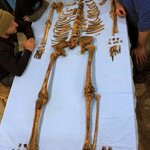Archaeology

Glastonbury - Britain's Oldest Glass Town
According to Wikipedia and many other online sources the origin of the name Glastonbury is unclear. On the contrary, it could not be more clear.
While idly thinking about a long-ago visit to Glastonbury Tor I chanced to reflect on the name Glastonbury. What, I wondered, was the true etymology of the name. The 'witrin' in the old Celtic name Ynys Witrin seemed to me to resemble the Latin term for glass. The modern Welsh equivalent 'ynys gwydr' means 'glass island'. Could the 'glas' of Glastonbury mean glass? What…

In the early part of the 20th century, after we had entered the Age of Flight, a strange phenomenon in Arabia was sighted.
Air travel had become more common and thus so did air delivery. British pilots flying from Cairo to Baghdad reported seeing ruins that no one had ever noticed before.
Visible from the air, in the middle of an unforgiving desolate place, were "kites" - well, walls that were vaguely shaped like kites - and they stretched for miles. This was before the UFO craze so there was no speculation about extraterrestrials, there were instead questions along the lines of…

It's believed that humans discovered fire over a million years ago but when it became something controlled and used for daily needs is unknown.
Fire is central to the rise of human culture and a discovery by archeologists at Qesem Cave, a site near present-day Rosh Ha’ayin in the Central District of Israel, has pushed the date for unequivocal repeated fire building over a continuous period
back a little farther - back to around 300,000 years ago.
Clearly, these prehistoric humans already had a highly advanced social structure and intellectual capacity. Dr. Ruth Shahack-Gross…

Archaeologists working at Abydos in southern Egypt have discovered the tomb of a previously unknown pharaoh named Woseribre Senebkay — and found the first material proof of a forgotten Abydos Dynasty from around 1650-1600 B.C.
The tomb of the previously unknown pharaoh Senebkay was discovered close to a larger royal tomb, recently identified as belonging to a king Sobekhotep, probably Sobekhotep I, circa. 1780 B.C. of the 13th Dynasty.
The discovery of pharaoh Senebkay's tomb is the culmination of work that began during the summer of 2013 when the Penn Museum team, led…
Volcanic rock textures and ages suggest that the painting of a mural by residents of Çatalhöyük was recording an explosive eruption of the Hasan Dagi volcano.
Scientists analyzed rocks from the nearby Hasan Dagi volcano in order to determine whether it was the volcano depicted in the mural from ~6600 BC in the Catalhöyük Neolithic site in central Turkey.
To determine if Hasan Dagi was active during that time, scientists collected and analyzed volcanic rock samples from the summit and flanks of the Hasan Dagi volcano using (U-Th)/He zircon geochronology. These ages were then compared to…

Learning about ancient civilizations used to mean hand-drawn maps and clunky tomes; now anyone can do it, using Google Earth and some idea of where to look and what to look for.
And Google Earth has helped create a map of an ancient Syrian trade route that shows how one city's political sway extended farther than believed. It still takes old-fashioned digging by others to have found the artifacts in the first place, but for visualization and understanding, the future is here.
"I trace the process of change by working with historical proxies, in this case coins," says Kristina Neumann, a…

Zaballa (Iruña de Oca) was a medieval settlement abandoned in the 15th century due to urban flight. Prior to that it had a manor monastery and later became something of a specialized factory location before its demise.
Zaballa is one of the more than 300 deserted settlements known in Alava-Araba - rural spaces abandoned in historical times but now being studied by the UPV/EHU's Cultural Heritage and Landscapes Research Group.
The most recent discoveries made there have been published in Quaternary International; most intriguing are terraced fields built in the 10th century —…

Cranial surgery is tricky business today. Patients will need an aseptic environment, specialized surgical instruments and copious amounts of pain medication both during and afterward.
In ancient Peru, trepanation - removing a section of the cranial vault using a hand drill or a scraping tool - was a lot more dangerous, and yet more common. They used it to treat a variety of ailments, from head injuries to heartsickness.
Excavating burial caves in the south-central Andean province of Andahuaylas in Peru, U.C. Santa Barbara archaeologist Danielle Kurin and colleagues unearthed the…

Over five-thousand years, cats began living alongside farmers in the ancient Chinese village of Quanhucun, according to a new paper. Probably because of rodents attracted to food.
Cat remains rarely are found in ancient archaeological sites, and little is known about how they were domesticated. Cats were thought to have first been domesticated in ancient Egypt, where they were kept some 4,000 years ago, but more recent research suggests close relations with humans may have occurred much earlier, including the discovery of a wild cat buried with a human nearly 10,000 years ago in Cyprus…

Archaeologists working in Nepal have uncovered evidence of a structure at the birthplace of the Buddha dating to the sixth century B.C., the first archaeological material linking the life of the Buddha and the movement he founded to a specific century.
The Maya Devi Temple at Lumbini, Nepal, has long been considered the birthplace of the Buddha and now excavations have uncovered the remains of a previously unknown sixth-century B.C. timber structure under a series of brick temples. Laid out on the same design as those above it, the timber structure contains an open space in the center that…